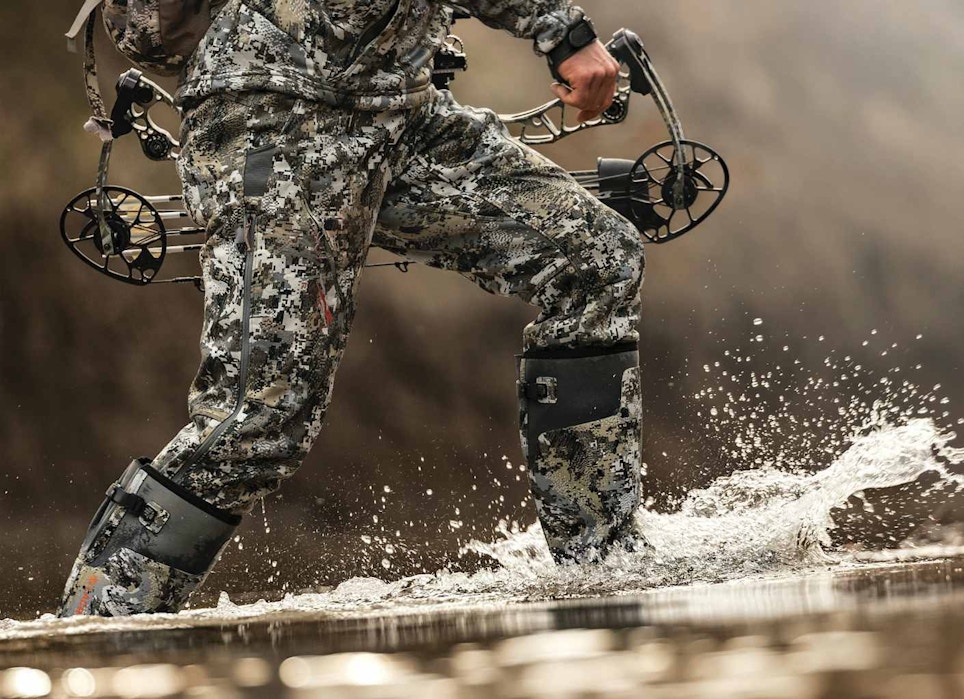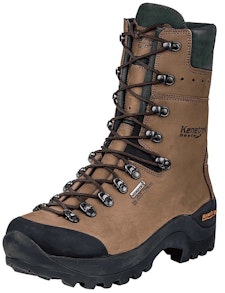
LaCrosse makes a wide variety of boots popular with hunters for year-round activities. (Photo: LaCrosse)
Every hunter needs a good pair of boots.
Since different types of hunting often require different styles of boots, a customer who buys one pair of boots from you is likely to return for more if he or she is happy with the purchase and your customer service.
Before we take a look at choosing types, brands and even models of hunting boots you might want to stock in your inventory, let’s first look at boot lingo. It might sound like a foreign language to some, but once you know what boot-specific terms are referring to, you’ll be better able to determine what boots you want on your shelves.
Boot Camp
Many boot terms are the same as those used for athletic shoes. The upper is the material above the midsole that covers the foot and ankle, and in non-rubber boots is typically leather or a nylon fabric. The midsole, which is typically glued or sewn to the boot, provides comfort by absorbing shock and, in some cases, providing thermal protection. The outsole is, just as it sounds, the outside of the bottom of the boot and is literally where the rubber meets the road — or woods, in this case.
Ethel Vinyl Acetate is the foamy material in the midsole of many boots that offers both support and insulation. The last is the aluminum structural part of the boot that provides stability and structure. Finally, the shank is a hard material, often fiberglass, that is glued under the arch between the outsole and midsole to provide support and added durability.
While there are many different types of hunting boots, there is a broad divide between rubber and neoprene boots and those made of leather, nylon and other materials. Rubber boots are typically taller and can keep a hunter’s feet dry even when walking in deep mud or several inches of water. They’re popular among waterfowl and deer hunters in many areas. While they serve certain purposes very well, they typically aren’t as comfortable as more fitted hunting boots.
The best advice for stocking rubber boots is to carry a variety of sizes in models with a wide range of price points. It’s also good to have a few models with different insulation values, since cold- and warm-weather needs vary.
The focus here is on boots that fall into the other categories.
Warm and Dry
Insulation levels will largely be determined by your location. If you’re down south where it stays fairly warm all year, you’ll likely want to lean more toward uninsulated models, but still carry some moderately insulated boots for those who suffer from cold feet no matter what. Just the opposite is true for retailers in the northern part of the country and the high mountains where it’s typically colder most of the season.
Most boots use Thinsulate insulation, a warm, thin and lightweight material made by the 3M company. It helps trap body heat while allowing moisture to escape, and it is typically measured in grams. The higher the Thinsulate number, the warmer the boot.
In a nutshell, boots with up to about 200 grams of Thinsulate are meant for mild hunting conditions. Think spring turkey hunting or deer hunting in warmer climates. They are also good even in cold weather when a lot of walking is involved. Thinsulate values of 400 to 800 are middle of the line and often good for mid-season hunts or when it’s likely to get cold and you will be sitting on a stand for hours.
For those who get cold feet easily or who will be sitting for long periods in very cold conditions, some boots have 1,000 grams of Thinsulate or more. A warning, though: These boots will make your feet uncomfortably warm if you try to use them for upland bird hunting or any activity where lots of walking is involved, especially in warm weather.
Waterproofing generally comes from inside of the boot rather than the outside. That’s because leather, while sometimes water resistant if treated, will eventually let water through if it remains wet for a long period of time. And wet feet usually equal cold feet. Gore-Tex liners solve that problem.
Unless they’re rubber, hunting boots that don’t have a waterproof liner might be water-resistant but they’re not truly waterproof. You should carry both styles in your lineup. While many hunters want the waterproofing qualities, some don’t ever plan to go out in wet weather or don’t want to pay the premium associated with truly waterproof boots.
Hunters typically select the amount of insulation needed and whether they want waterproof boots based on what kind of hunting they’ll do and the areas they plan to hunt. If they’ll be in cold conditions or sitting most of the time, they’ll usually opt for more insulation. Hunters who walk a lot in warmer climates might choose boots with no insulation at all.
As mentioned earlier, most hunters need multiple boots for different purposes. A lightweight upland boot worn hunting quail in the Arizona desert won’t keep your feet warm on a Michigan deer stand in late November.
The Right Fit
Fit is one of the most important aspects of a good set of hunting boots, and this is where brick-and-mortar retailers have an advantage over their online competitors.
Hunting boots should fit snugly around the ankles and insteps, while providing plenty of room for the toes to move a little. Let customers wear boots for a brisk hike around the store to see how they feel while walking. If their feet slide forward and backward in the boot, they’ll need a narrower width. Remember, friction leads to blisters, and blisters are the bane of many hunters.
Hunters who frequently head out into cold weather often wear thick socks. Take this into consideration when helping them determine a boot size, as they’ll sometimes need to go larger. If they don’t get a larger boot, their feet could be cramped and uncomfortable. They’ll also be more likely to get cold feet because of reduced circulation. Note that it’s best for customers to try on new boots late in the day when their feet are already swollen, since that typically yields a more accurate size.
Hunters with flat feet or other special foot needs often prefer a premium insole in their hunting boots. Carrying a good selection in a few different price ranges will lead to add-on sales.
Quality Options
When it comes to choosing boots to carry in your lineup, a basic selection of insulated and noninsulated boots in a variety of price ranges can give your customers everything they need.
First, let’s look at insulated boots. These are ideal for cold-weather climates, late-season hunts even in warmer regions and any hunt where you’re sitting around a lot and likely to get cold feet.
Kenetrek’s new-for-2020 Mountain Guide 400 is an excellent example. With a premium full-grain leather upper, these 10-inch-tall boots have reinforced double and triple stitching in high-wear areas. They also have 400 grams of Thinsulate to keep your customers’ feet warm in cold weather and a breathable Windtex waterproof lining to keep feet dry.
Of course, not all of your customers want an insulated boot in the $500 range. Fortunately, there are many options at lower price points to give them a purchasing opportunity.
LaCrosse’s 4X Alpha Snake Boots are quality rubber boots that will keep hunters’ feet dry even in deep mud and muck. Known for their toughness, durability and comfort, they feature a rubber sole and a temperature rating of minus 20 degrees F.
For customers looking for boots on the very warm end of the spectrum, Guide Gear’s Monolith Waterproof bootsreally fit the bill. Made of suede leather with nylon uppers, they feature 2,400 grams of Thinsulate to keep feet warm in even the coldest hunting conditions.
For uninsulated boots, Kenetrek also produces a fine, top-of-the-line boot in the Mountain Extreme Ni. With a waterproof, breathable membrane, it’ll keep your customer’s feet dry and comfortable, and since it’s noninsulated it is great for warm-weather hunts.
Irish Setter’s 2870 Vapetrek is an 8-inch hunting boot with a waterproof lining that also utilizes scent-proofing technology for big-game hunters. Made of a composite material, these boots are up to 50 percent lighter than many competitors, making them ideal for hunters walking long distances.
Made of 100 percent Nubuck leather, Lowa’s Tibet GTX Trekking boot is a good boot for mountain hunters and others spending a lot of time on the trail. With a seamless Gore-Tex lining, they’ll never leak a drop. And the rugged Vibram outsole works well for hunters and backpackers alike, even on rough, slick terrain.
Of course, there are many other boots on the market from a large number of manufacturers. While the ideas presented here should help you decide what to stock, only you know for sure what customers in your area are most likely to purchase.






